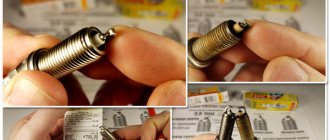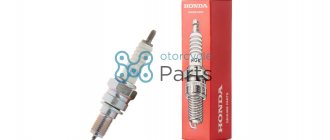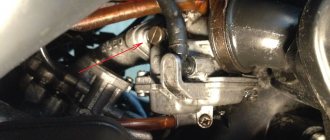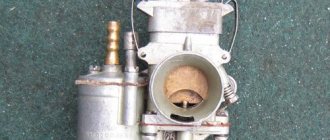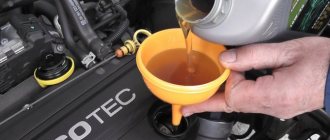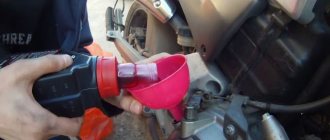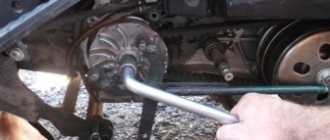"Chinese"
We inspect the right side of the engine and if you find there a thick black wire at the end of which there will be an incomprehensible L-shaped piece of garbage inserted into the engine. Decide whether it will be convenient for you or not, if it is convenient, remove this garbage from the spark plug and, as necessary, put a special key on the spark plug and unscrew it
If inspection of the engine yields nothing, inspect the engine hood and if you see a hatch in its front part, remove it
If there is no hatch on the hood, remove either the hood or the seat tank
How to properly replace a spark plug on a scooter with your own hands
Unscrew the old spark plug
Scooter manufacturers, as a rule, provide various hatches and compartments in the design to facilitate access to the spark plug. If there are none, access is provided from the bottom or from the rear wheel, as, for example, on Honda Dio AF-18, 27, etc. scooters.
How to change?
We take it, buy it, ask someone for a special spark plug wrench. We put the key on the spark plug, insert a screwdriver into the key and turn the spark plug out. After unscrewing the spark plug - carefully so as not to accidentally drop it into the cooling casing - remove it along with the key
As necessary, we insert a new spark plug into the key and very carefully and slowly screw it into place. When you wrap the candle, do not apply much force to it, and if you feel that at the very beginning the candle is wrapped tightly, then you have not hit the thread: unscrew it and try to screw it again.
If the candle went easily, wrap it all the way and pull it slightly. It is not advisable to tighten the candles too much; it will be enough to tighten them a little and this will be quite enough.
How to identify engine problems based on the condition of the spark plug?
In order to determine engine problems based on the condition of the spark plug, you need to properly prepare it. And so, start the moped engine and ride it at a speed of 40-50 km/h. You need to drive about 10 km. When you arrive, turn off the engine, be sure to let it cool, and only after it has cooled do you unscrew the spark plug. Another thing that needs to be clarified is that as soon as you stop, immediately turn off the engine; if you let the engine idle while stopping, then you will have to drive 10 km again.
- The color of a candle is determined only by the central part of the candle itself. Let's look at the picture. This candle has the correct brown color, but the other side is almost white. This means that the mixture does not ignite evenly in the cylinder. Because of this, it may happen that 1 part of the candle is white and the other is brown. In this case, the engine runs a little lean. It's not scary - it's within the normal range. In this mode you will get slightly less fuel consumption, but also less engine power. photo 1
- On the next candle we also see carbon deposits and the insulator is also black, but on the other side it is brown.
This means that the engine runs on a slightly rich mixture. This is good because you will get a little more power, but the bad thing is that you will have a little higher fuel consumption. But this is also the norm. The engine is running normally. photo 2 - We look at the picture, as we see there is practically no black soot on this candle, the insulator is slightly brown, and the other sides are white.
This means that the engine is running on a lean mixture - this can cause both engine overheating and improper combustion of the mixture and increased fuel consumption. This kind of candle is no longer the norm. Also, if the mixture is too lean, you will see white deposits on the spark plug (they are difficult to notice), which means your engine is running on a too lean mixture and you need to urgently adjust the carburetor. photo 3 - This spark plug shows that the engine was running on a very rich mixture.
The entire candle is black. This immediately means increased fuel consumption and slightly less engine power. If you see such a spark plug, you definitely need to adjust the carburetor. Also look inside the spark plug, if you see oil deposits there, this should not be the case. This means that you need to change the rings or valve stem seals. (oil has the right to appear only on the thread). photo 4 - If you see metal dust on the spark plug, this means that your engine has begun to deteriorate.
Either you were driving at too high speeds or the mixture was lean for too long. If you see, through a magnifying glass or without it, marking points on the spark plug and so on, then you may soon have to change the engine, or rather the CPG. The dots should be shiny. photo 5 - If the edge of the spark plug is slightly rounded, this means that erosive wear has begun.
Those. the candle worked for so long that metal particles simply began to evaporate from it. The same thing can be found on the electrode of the spark plug; if you see that the spark has made a groove, then everything is fine with the engine, but you just need to change the spark plug. If you see a crack on the insulator, you need to change the spark plug immediately. And if the insulator completely shatters, then disassemble the CPG immediately, because fragments of the spark plug got into the cylinder and could scratch the walls, valves, and rings there. photo 6
Badly
0
Interesting
15
Super
0
How to check the spark?
We insert the spark plug into the spark plug cap and place the spark plug on the engine so that its metal base touches any metal part of the engine. Turn on the ignition, press the start button or kickstarter foot and look at the spark plug electrodes.
- If there is a spark between the electrodes, the spark plug is working
- If there is no spark between the electrodes, the spark plug is broken; to be sure of this, try a known good spark plug or a new spark plug.
- If there is no spark and there is a working spark plug, the spark plug has nothing to do with it and the problem is not in it, but for example in the coil, switch or generator
When to change a spark plug on a scooter
Ideally, the spark plug electrodes should be light brown, without noticeable deposits of carbon deposits and rust. The formation of a velvety soot indicates a rich mixture or excessive wear of the CPG. White electrodes with a clear sign of melting or overheating indicate a lean mixture when the proportion of oxygen to gasoline is increased.
In any of the above cases, it is necessary to adjust the quality of the mixture. If the adjusting screws on the carburetor do not respond to adjustment, as well as the movement of the needle, it is obvious that the carburetor is clogged or the wear of the CPG has reached a level where it is impossible to do without replacing the elements of the piston group.
Spark plugs and heat rating
Before I got acquainted with the scooter, I had little idea about spark plugs. But nevertheless, I bought a candle as one of the first parts for a scooter. At that time I didn’t yet understand the markings, and I bought it simply by the name “Candle for Honda Tact.” And then on the Internet I found a convenient table for NGK spark plugs, and after looking at it, I wanted to understand the topic in a little more detail, and especially to understand what the heat rating of a spark plug is. After all, it was this term that interested me most.
To choose the right spark plug, you just need to look at the scooter manual. Most common candles have analogues produced by several companies. Although NGK candles are the most popular due to their quality and reasonable price.
NGK spark plug marking table
Let's take the standard Honda Dio spark plug as an example - this is an NGK spark plug marked BPR6HS .
The first one or two characters indicate the thread diameter and key size.
- A
– 18 mm (hex key 25.4 mm) - B
– 14 mm (hex key 20.8 mm) - C
– 10 mm (hex key 16.0 mm) - D
– 12 mm (hex key 18.0 mm) - E
– 8 mm (hex key 13.0 mm) - G
– PF 1/2 (hex key 23.8 mm) - J
– 12 mm (hex key 18.0 mm) - AB
– 18 mm (hex key 20.8 mm) - BC
– 14 mm (hex key 16.0 mm) - BK
– 14 mm (hex key 16.0 mm) - DC
– 12 mm (hex key 16.0 mm)
The next two symbols indicate the features of the candle.
- K
– protruding end for 3/8″ wrench - L
– compact type (Shorty) - M
– compact type (Bantam) - P
– protruding insulator - R
– resistor - U
– surface or semi-surface discharge - Z
– induction resistor
Then comes a number indicating the heat value. Can take a value from 2 to 12. The higher the number, the colder the candle.
- 6
– heat number
The next symbol indicates the thread length.
- E
– 19 mm - H
– 12.7 mm –
standard for Honda Dio - EH
– half thread: total length 19.0 mm and thread length 12.7 mm - FS
– with 10.9 mm conical seat - L
– 11.2 mm - S
– 9.5 mm - Z
– 21.0 mm
The following symbol indicates the shape and characteristics of the electrodes.
- A
– with special design - B
– for CVCC engine - C
– low angle side electrode - CM
– compact type with oblique ground electrodes - E
– V-shaped corrugated electrode (14.0 mm only) 1.5 mm insulator - ES
- standard spark plug with a long threaded part of 2.5 mm with a central electrode location - F
– with conical seat - G
– central electrode made of thin nickel alloy - GG
– copper electrode with grounding - GV
– gold-palladium central electrode - J
– two extended side electrodes - K
– two side electrodes - M
– two side electrodes, insulator length 18.5 mm - T
– three side electrodes - Q
– four side electrodes - R
– special electrode with grounding - S
– standard central electrode made of copper 2.5 mm - P
– central electrode made of platinum - U
– semi-surface discharge - V
– central electrode made of gold-palladium - VX
– special side electrode, center. platinum electrode - W
– tungsten central electrode - X
– clearance for increased productivity - Y
– V-shaped central electrode - -L
– intermediate thermal rating - -LM
– compact type (insulator length 14.5 mm) - -N
– grounding electrode with special dimensions - IX
– central electrode made of iridium - Z
– central electrode thickness 2.9 mm
The spark plug marking may end with a number indicating the spark plug gap in tenths of a millimeter. For example, - 11 indicates a gap of 1.1 mm.
So, our BPR6HS has the following features:
- B – 14 mm thread for a standard 21 mm wrench
- P – with protruding insulator
- R – with resistor
- 6 – with heat number 6
- H – with thread length 12.7 mm
- S – with standard central electrode
The main thing when selecting an analogue is the correspondence between the physical characteristics of the candle and the heat rating. And the shape and type of electrodes are secondary.
Spark plug heat number
The heat number is a conditional value. Previously, it indicated the time (in seconds) after which the spark plug warmed up to the state at which glow ignition began (when the fuel ignites not from a spark, but from the hot working parts of the spark plug). Now the heat number is the average indicator pressure at which heat ignition begins. The higher the heat rating, the longer the candle prevents overheating. Therefore, the colder it is. A candle with a lower heat rating is hot.
The normal temperature of the working part of the candle is 500-600 °C. In this case, the spark plug cleans itself and works correctly. If the temperature is lower, carbon deposits accumulate on the working parts of the spark plug, causing current leakage, causing the engine to start unstably and run intermittently. If the temperature rises to 800 °C, then there is a danger of glow ignition, and the mixture ignites before the required moment, which leads to loss of power and high gasoline consumption.
If you use your scooter for short trips, it is better to use a hotter spark plug (for example, number 5 or 6), it will be most effective. And if you drive long distances, or with a heavy load, a cold spark plug (with a heat rating of 7 or to avoid hot ignition - after all, during intensive work, the spark plug is prone to overheating) is suitable.
And if you drive long distances, or with a heavy load, a cold spark plug (with a heat rating of 7 or to avoid hot ignition - after all, during intensive work, the spark plug is prone to overheating) is suitable.
Exactly the same rule can be followed for seasonal use of a scooter. Not all scooter riders park their horse in the garage in winter. If you continue to ride your scooter in the cold, it makes sense to use a hotter spark plug. And in the hot summer it will be correct to drive with a cold spark plug.
By the type of candle you can conditionally determine whether the heat number is selected correctly. The normal color of the insulator should be light brown. If the insulator is very light or even white, the plug is too hot for the engine. If, on the contrary, the insulator is covered with black soot, you need to put a hotter candle. Of course, this conventional method only works with a correctly configured carburetor.
Please note: This article and the images in it are subject to copyright. Partial or complete reproduction on other resources without permission is prohibited.
